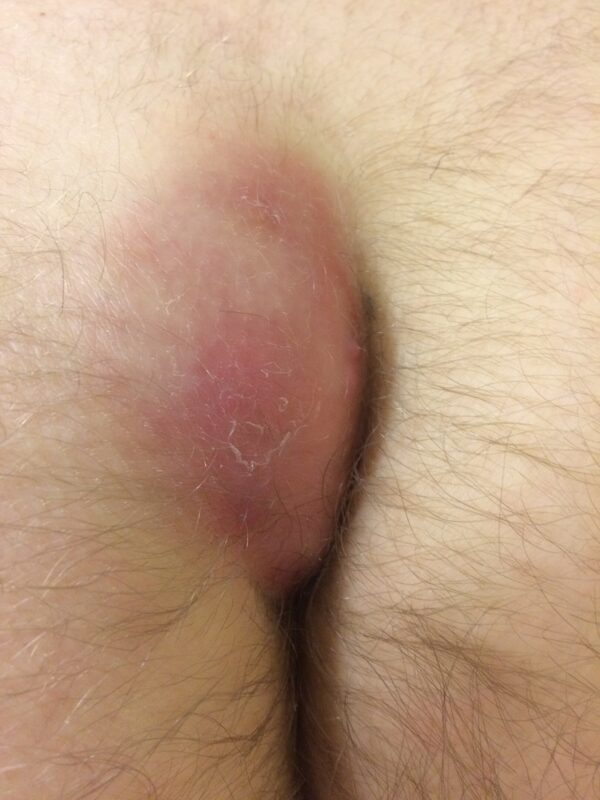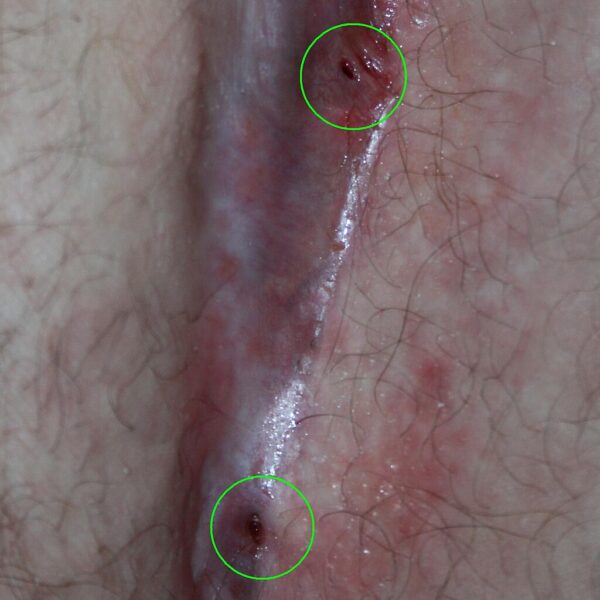- 📖 Geeky Medics OSCE Book
- ⚡ Geeky Medics Bundles
- ✨ 1300+ OSCE Stations
- ✅ OSCE Checklist PDF Booklet
- 🧠 UKMLA AKT Question Bank
- 💊 PSA Question Bank
- 💉 Clinical Skills App
- 🗂️ Flashcard Collections | OSCE, Medicine, Surgery, Anatomy
- 💬 SCA Cases for MRCGP
To be the first to know about our latest videos subscribe to our YouTube channel 🙌
Table of Contents
Introduction
Pilonidal disease encompasses the acute presentation of a pilonidal abscess and the chronic condition pilonidal sinus. These are related conditions involving the natal cleft.
A pilonidal abscess is a painful, pus-filled infection that results from hair penetrating the skin. A chronic pilonidal sinus, on the other hand, is a persistent tract under the skin where hair and debris collect, often leading to recurrent infections.
Aetiology
The aetiology of pilonidal disease is not clear.
Pressure, friction, or another underlying skin problem causes hair that gathers at the natal cleft (top of buttocks) to be pushed inwards. This hair can be local to the buttocks, from elsewhere on the body, or even hair of a close contact, such as a partner who shares the bed!
Risk factors
Risk factors for pilonidal disease include:
- Male sex
- Age 16-40
- Coarse dark hair
- Hirsute people
- Obesity
- Diabetes
- Eastern Mediterranean races
- Jobs involving long seated periods (e.g. lorry drivers, crane operators etc.)
Clinical features
Patients can present acutely or with more chronic symptoms.
History
The acute presentation of a pilonidal abscess is pain, erythema, and swelling in the natal cleft. This may be associated with a history of recurrent infections or abscesses requiring antibiotics or incision and drainage.
Unwell patients may have more systemic symptoms.
Patients with more chronic disease will complain of multiple infective episodes with the requirement for antibiotics and/or incision and drainage of an abscess. They will often say that the symptoms never entirely resolve and may have chronic leakage from the pits in the midline.
Clinical examination
If the patient presents acutely, an erythematous abscess may be present, similar to Figure 1. Unwell patients may display signs of sepsis.
Midline pits, as per Figure 2, may also be visible if there is a chronic history. In both the acute phase and chronic disease, the area might be uncomfortable.
Differential diagnoses
With acute presentations, it is important to differentiate between a pilonidal abscess and buttock or perineal abscesses by inspecting the affected area.
Investigations
Pilonidal disease is diagnosed clinically, and further tests are rarely required. In extensive disease with complex pits and sinuses, an MRI scan can be performed to delineate disease and aid surgical planning.
In recurrent disease, it is appropriate to test for diabetes.
Management
Medical treatment
Antibiotics can be used to treat small abscesses acutely or for low-grade septic episodes.
Acute management
For patients who are systemically unwell, have not resolved with a course of oral antibiotics or who have a large abscess, then surgical incision and drainage of the abscess is the preferred treatment. This can be performed under local or general anaesthetic.
The patient should be consented and marked for “Incision and Drainage of Pilonidal Abscess” appropriately assessed and prepared by the anaesthetic and nursing teams. The patient should be positioned on their side with the abscess side closest to the bed to allow easy access.
Initially, the surgeon should examine and assess the natal cleft. An incision should be made over the fluctuant area, and the abscess cavity should be drained, explored, and washed out. Packing can be used for haemostasis, but regular long-term packing is no longer routinely recommended.1
Patients can then be discharged, and if the disease is significantly affecting their lives, they can be referred for routine colorectal surgery follow-up to consider definitive surgical treatment.
Conservative treatment
Shaving or other hair removal techniques for local hair may control symptoms or reduce the frequency of flares, and patients should be counselled about personal hygiene.
Surgical treatment
For patients with multiple infected episodes and debilitating disease, definitive surgical treatment may be required.
There are several eponymous techniques for excision of the sinus and closure of the skin (Bascom, Karayadaki) or local rotational skin flaps.
Patients are usually placed in the prone position for the surgery with the buttocks spread with tape for the excision and then released during the closure phase. An asymmetrical excision of the central sinus pits and their lateral tracks is then performed. The skin flaps are then mobilised and the skin is closed so that the wound is not in the midline of the cleft.2
Minimally invasive procedures include laser ablation and endoscopic ablation.
Complications
Wound infections and poor healing are the predominant complications of surgical management, and a failure rate of around 25% is reported.3 This failure rate is higher in the more novel and minimally invasive procedures.
Key points
- A pilonidal abscess is caused by hair being pushed inwards at the top of the buttocks
- This can present acutely with an abscess or more chronically with low grade infection of pits
- Antibiotics can be used for small abscesses or for controlling chronic infection
- Incision and drainage is the surgical approach acutely
- Elective excision of the natal cleft is the definitive surgical option if the disease is having a significant affect on a patient’s life but the risk of wound failure is high.
Editor
Dr Chris Jefferies
References
- Miller AS, Boyce K, Box B, Clarke MD, Duff SE, Foley NM, et al. The Association of Coloproctology of Great Britain and Ireland consensus guidelines in emergency colorectal surgery. Colorectal Dis. 2021;23(2):476-547.
- McLatchie G, Borley N, Chikwe J. Pilonidal Sinus Disease. Oxford Handbook of Clinical Surgery: Oxford University Press; 2013. p. 744-745.
- Steven R Brown, Daniel Hind, Emily Strong, Mike Bradburn, Farhat Din, Ellen Lee, Jon Lund, Christine Moffatt, Jonathan Morton, Asha Senapati, Helen Jones, Matthew J Lee, PITSTOP Management Group , Real-world practice and outcomes in pilonidal surgery: Pilonidal Sinus Treatment Studying The Options (PITSTOP) cohort, British Journal of Surgery, Volume 111, Issue 3, March 2024






